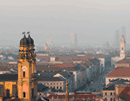European Infrastructures and Transnational Protest Movements
Workshop
12.12.2019 – 13.12.2019
Location: Kerschensteiner Kolleg of the Deutsches Museum, Munich
Sponsors: the Austrian Research Foundation (FWF), the Swiss National Science Foundation (SNF) and the German Research Foundation (DFG)
Co-Organizer: the Rachel Carson Center for Environment and Society, Munich
-- You can now read a report of the conference of this event on the RCC blog Seeing the Woods --
Large-scale infrastructure projects and technologies have often been met with social resistance. Energy and transport infrastructures in particular have led to fierce and at times violent protest movements. Recent German examples of public protest against infrastructure projects include “Stuttgart 21,” over the reconstruction of Stuttgart main station and respective tributary railroad lines, and “Hambacher Forst,” over the extension of lignite open-cut mining into a small forest area between Aachen and Cologne. Both projects have become synonymous with civil disobedience against state and corporate interests—what social scientist James Scott would see as proof for the existence of “high modernism” in the twenty-first century.
Social protest against infrastructure projects and large-scale technologies has in fact a much longer and richer history. The new social movements that emerged not only in Germany but in many other Western European nations in the course of the 1960s and 1970s were often catalyzed by opposition to infrastructures which were understood as advancing technocratic and authoritarian policies and structures. The advance of nuclear energy in particular served as a seedbed for new social movements that encompassed left-wing fractions, Protestant churches, and everything inbetween. Sites of proposed nuclear reactors and transport infrastructures developed into protest zones, becoming what historian Frank Uekötter has called “environmental sites of memory.” In the German case, the nuclear power plants in Wyhl and Brockdorf, the planned nuclear reprocessing and storage sites in Wackersdorf and Gorleben, and “Startbahn West” at Frankfurt Airport have become signifiers for large-scale social protests, deeply engrained into the collective memory of the nation. The same holds true for Windscale/Sellafield in Great Britain, Fessenheim and Creys-Malville in France, Zwentendorf in Austria, and Ascó and Lemóniz in Spain, to name just a few. Nuclear energy for civil society has developed into a “public technology” (Helmuth Trischler and Robert Bud) that is deeply shaped by public engagement.
Wyhl also stands out as an early example of a trans-national protest movement. The small wine-growing village in southwest Germany experienced solidarity from neighbouring French Alsace and Swiss Basel. In the beginning, such protest movements had difficulties becoming international, but during the 1970s and 1980s, global resistance against nuclear power allowed for the transfer of knowledge, the transnational exchange of counter-expertise, and the rise of border-crossing protest cultures.
Similar patterns of social protest that oscillate between the regional and national poles on the one side and transnational concerns on the other can be observed in the case of European infrastructure projects, such as Alpine transit routes. The controversies over the construction of large-scale Alpine transit infrastructures both at the Gotthard and the Brenner Passes are currently being studied by the joint Austrian-German-Swiss research project “Issues with Europe: A Network Analysis of the German-speaking Alpine Conservation Movement (1975-2005),” based at the Universities of Innsbruck and Basel and the Rachel Carson Center in Munich.
You can find the program here.


